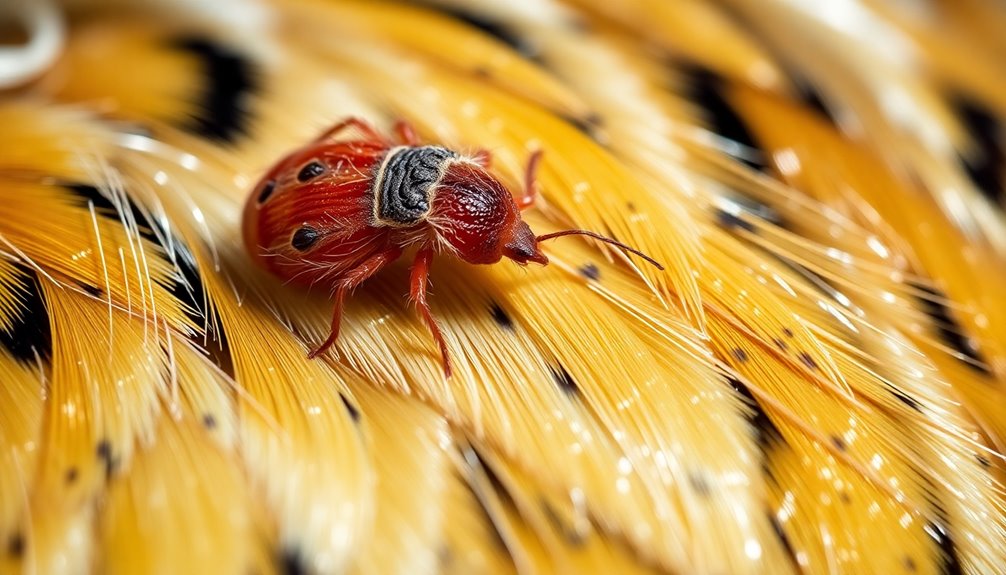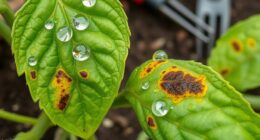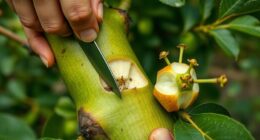Quail mites, tiny pests under 1 mm, could seriously impact your flock's health. Watch for signs like excessive scratching, frayed feathers, and redness under the wings. If you notice these symptoms, it's essential to act quickly. You can treat infestations with insecticides like permethrin or natural options such as diatomaceous earth. For prevention, regularly clean your coop, quarantine new birds, and encourage dust baths. A balanced diet is also important for boosting your birds' immunity. Understanding all the steps can help keep your quail safe and healthy, so there's much more to discover on effective management.
Key Takeaways
- Quail mites are tiny and reddish after feeding, with signs including excessive scratching, frayed feathers, and skin irritation under wings.
- Treatment options involve chemical insecticides like permethrin and natural remedies such as diatomaceous earth and neem oil for effective management.
- Regular cleaning and sanitizing of coops, along with quarantining new birds, are essential preventive measures against mite infestations.
- Provide dust baths using sand or diatomaceous earth to help quail naturally control parasites and maintain feather health.
- Conduct routine health checks to identify signs of infestation early and ensure a balanced diet to support overall quail immunity.
Identifying Quail Mites
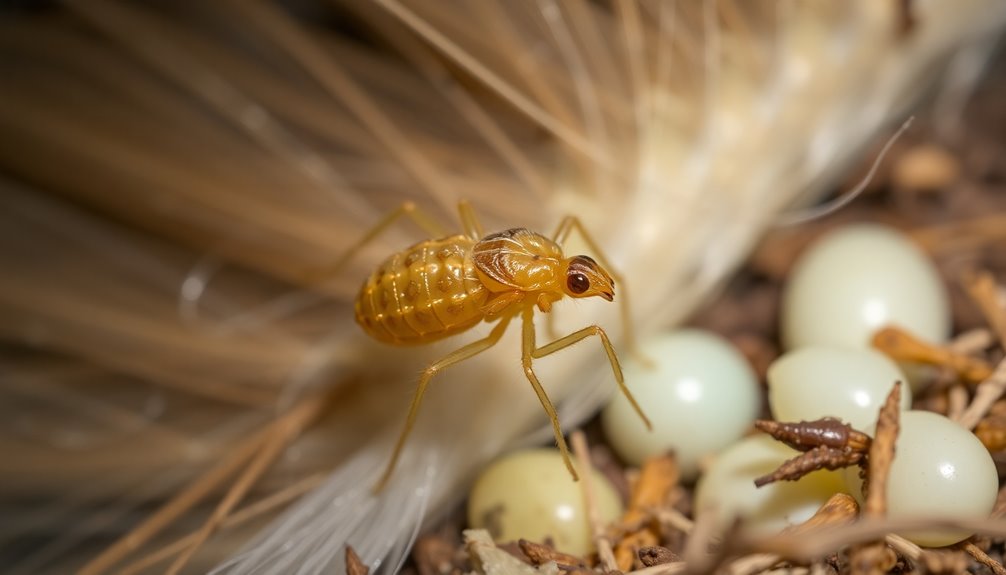
When you're trying to identify quail mites, it's vital to look for specific signs that indicate an infestation. These tiny ectoparasites, like the Northern fowl mite and red mite, measure less than 1 mm and often appear reddish after feeding on bird blood.
You should watch for excessive scratching, frayed feathers, and visible mites or nits around the quail's vent and wings. Additionally, if you notice symptoms such as lethargy or restlessness, it may signal a problem.
Keep an eye out for physical indicators like redness, scabs, or crusty skin, especially under the wings. Regular health checks and monitoring are important for early identification, ensuring you can take action before the infestation worsens.
Signs of Infestation
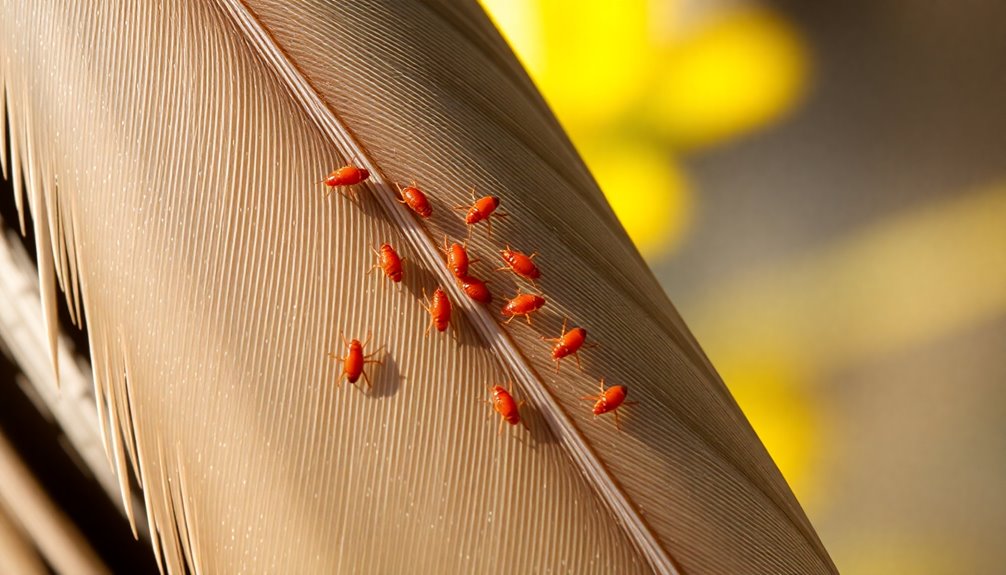
Noticing the signs of quail mite infestation early can save you a lot of trouble down the line. Look for excessive scratching, which shows your quail are uncomfortable. You might also see frayed feathers, especially around the vent and wings where mites and other parasites often gather.
Affected birds may act restless and frequently shake their heads to relieve irritation. Physical signs like redness, scabs, or crusty skin under the wings indicate a serious issue.
Additionally, if your quail start avoiding nesting areas, it's a clear sign of infestation, as they feel uneasy in infested spaces. Keep an eye on egg production, too—any noticeable drop can signal the stress caused by these pests.
Treatment Options
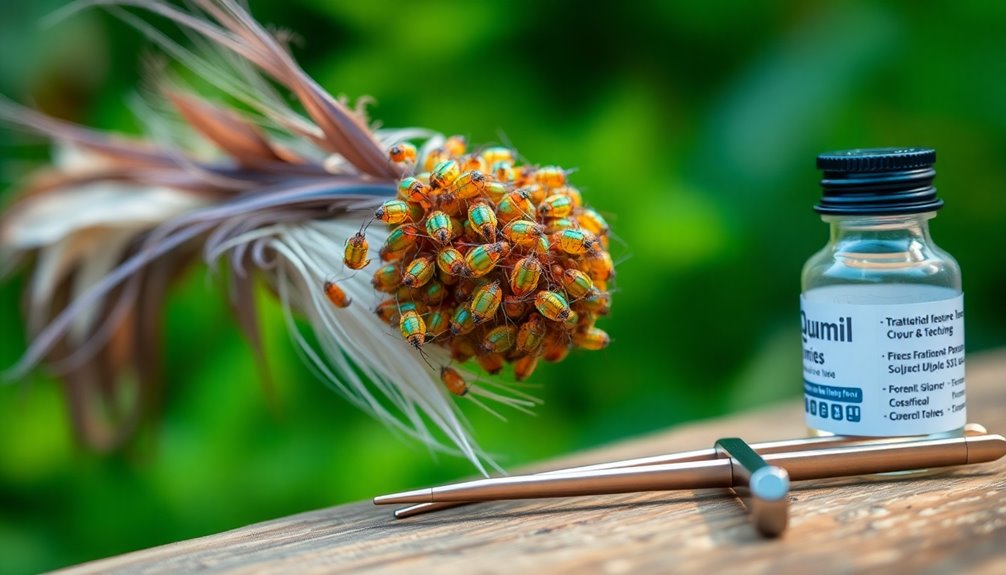
When it comes to treating quail mites, you've got several options to take into account, including both chemical treatments and natural remedies.
It's important to understand the application techniques for each method to maximize effectiveness and guarantee the safety of your birds.
Let's explore these treatment options to help you make the best choice for your quail.
Chemical Treatment Options
Chemical treatment options for quail mites play an important role in managing infestations effectively. Commonly used chemical treatments include insecticides like permethrin, which is known for its low toxicity when properly diluted—about one ounce per five gallons of water.
Always follow the manufacturer's instructions for dosage and application to guarantee safety and effectiveness during a mite infestation. It's vital to isolate affected birds during treatment to prevent spreading mites to healthy ones.
Additionally, thorough cleaning and disinfection of the coop are significant steps to take. After applying chemical treatments, monitor your quail closely for signs of reinfestation or adverse reactions, as regular health checks can help catch any issues early and keep your flock healthy.
Natural Remedies
For those seeking alternative solutions, natural remedies can be an effective way to manage quail mite infestations.
One of the best methods is to provide dust baths using food-grade diatomaceous earth. This substance dries out mites, causing dehydration without harming your quail. You can also sprinkle diatomaceous earth in their feed to help manage internal parasites, promoting overall health and immunity.
Regularly offering shallow trays filled with sand or diatomaceous earth encourages quail to engage in their natural dust bathing behaviors, essential for feather health.
Additionally, consider using diluted neem oil as a natural treatment, or mixing garlic or apple cider vinegar into their drinking water to boost immunity and create an environment less favorable for mites.
Application Techniques
Natural remedies can provide a solid foundation for managing quail mite infestations, but employing effective application techniques is key to achieving lasting results.
Start by applying anti-mite or anti-lice sprays according to the manufacturer's instructions, ensuring you cover all affected areas thoroughly while avoiding food and water sources.
Incorporate food-grade diatomaceous earth in dust baths by sprinkling it liberally, allowing quail to dust bathe, which helps control mite populations effectively.
For permethrin treatments, dilute one ounce in five gallons of water, spraying crevices and perches where mites hide.
Regularly inspect your quail for signs of reinfestation, like excessive scratching or feather loss, and reapply treatments if necessary.
Isolate affected birds during treatment to prevent spreading lice and mites.
Preventive Measures
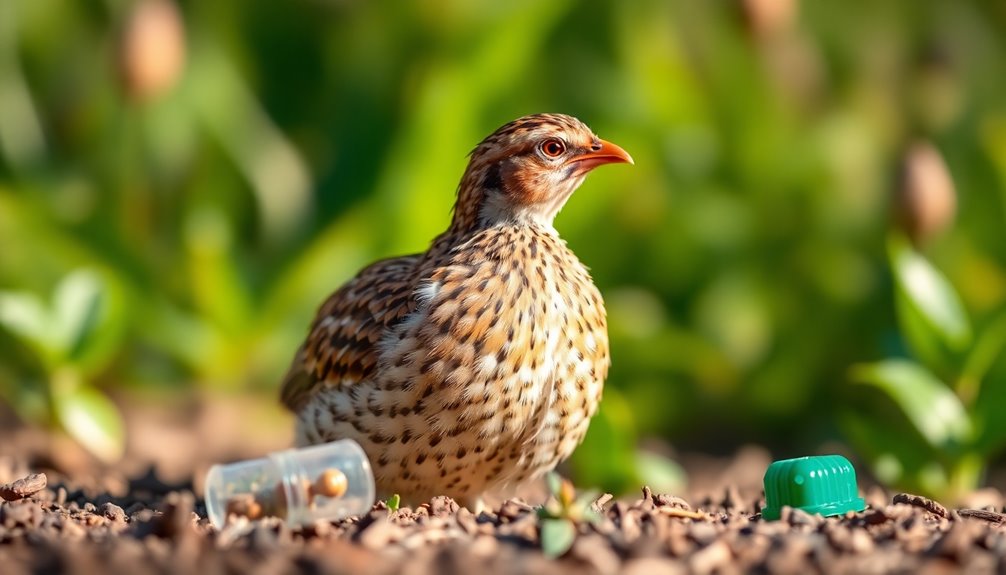
How can you effectively prevent quail mite infestations?
Start by regularly cleaning and sanitizing your quail coops and aviaries. Replace bedding with straw or wood shavings frequently to eliminate potential mite habitats.
Quarantine new birds for 2-3 weeks before introducing them to your existing flock; this helps monitor for any signs of mite infestations.
To support your quail's natural behaviors, provide shallow trays filled with sand or diatomaceous earth for dust baths, which can help control external parasites like mites.
Additionally, minimize contact with wild birds by using netting or barriers.
Finally, rotate bedding areas and guarantee your quail receive balanced nutrition to maintain their overall health, as healthy birds are less susceptible to mite infestations.
Long-Term Care Strategies
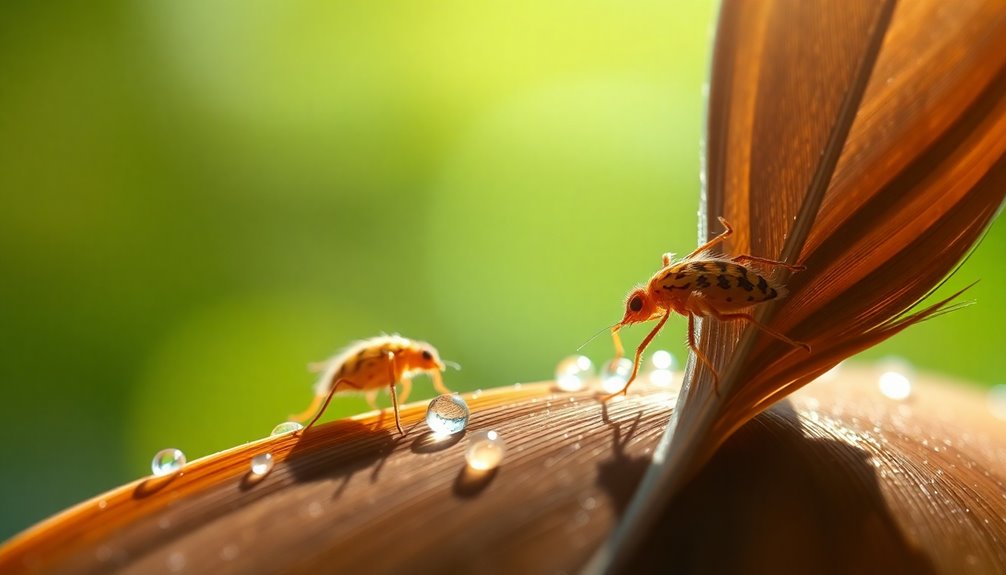
Maintaining long-term care strategies is essential for keeping your quail healthy and free from mite infestations. Regularly inspect your birds for signs of mites, like excessive scratching and feather loss, to catch issues early.
A clean environment is important; sanitize coops and replace bedding frequently to deter mites and promote overall health. Encourage dust bathing using sand or diatomaceous earth, as this helps quail groom themselves naturally and control mite populations.
Implement a routine health check schedule to monitor your quail's well-being, addressing any signs of illness promptly. Finally, provide a balanced diet rich in protein and nutrients to boost their immune system, making them less susceptible to parasites like mites while raising quail successfully.
Natural vs. Chemical Solutions
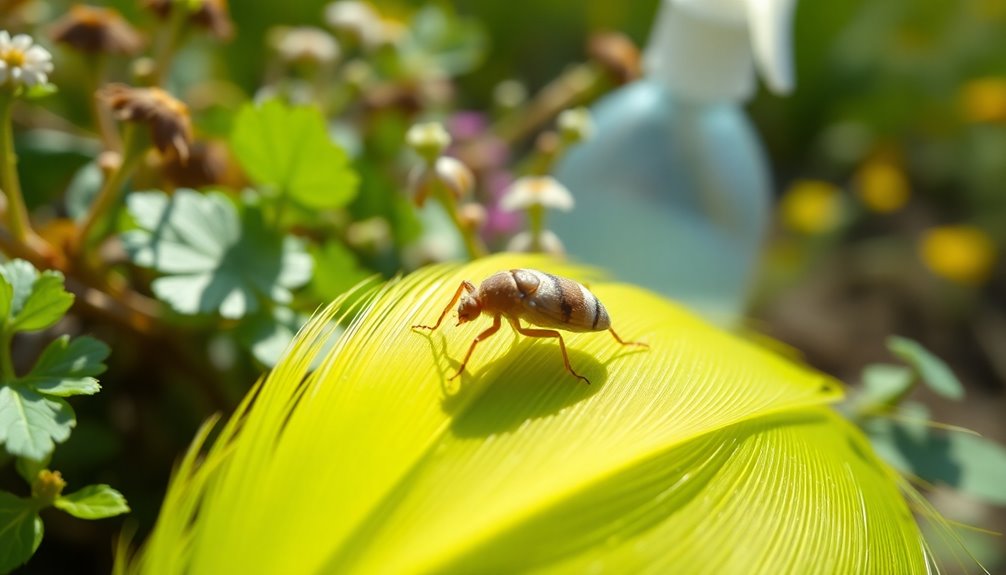
When it comes to treating quail mites, you've got two main options: natural solutions and chemical treatments.
Natural solutions, like food-grade diatomaceous earth, are great for promoting quail health without leaving chemical residues. When you apply it in dust baths, it effectively dries out mites and can improve feather quality within one to two weeks. However, these methods take longer to show results.
On the other hand, chemical treatments, such as permethrin, are potent and work quickly, but they may leave chemical residues in your quail's eggs and meat. If you choose chemicals, remember to monitor closely to avoid toxicity.
Ultimately, you'll need to weigh the benefits of each approach based on your goals for your flock's health and safety.
Frequently Asked Questions
How to Prevent Mites in Quail?
To prevent mites in your quail, regularly clean and sanitize their living areas, replacing bedding to eliminate potential habitats.
Quarantine new birds for 2-3 weeks to monitor for signs of infestations.
Provide shallow dust baths with sand or diatomaceous earth to encourage natural behaviors that control mite populations.
Minimize contact with wild birds using barriers and conduct weekly health checks to catch issues early, ensuring your flock stays healthy and mite-free.
How to Tell if Quail Has Mites?
To tell if your quail has mites, watch for excessive scratching, frayed feathers, and restlessness.
Check for redness, scabs, or crusty skin around the vent and under the wings. You might notice your quail shaking its head or avoiding nesting areas, indicating discomfort.
During evening inspections, look for visible mites or small brown specks in their feathers.
Finally, keep an eye on egg production; a drop could signal stress from mites.
How to Prevent Quail Disease?
Keeping your quail healthy is like nurturing a garden; both need care and attention.
To prevent quail disease, you should maintain a clean environment by regularly sanitizing coops and replacing bedding.
Quarantine new birds for 2-3 weeks to monitor for sickness.
Offer dust baths with sand or diatomaceous earth to promote natural grooming.
A balanced diet rich in protein supports their immune health, so make sure they get all the nutrients they need!
What Are the Symptoms of Bird Mites?
When you're dealing with bird mites, you'll notice your birds scratching excessively and their feathers looking frayed.
You might see redness or scabs on their skin, especially around the vent and wings. Your quail may act restless, shake their heads often, and have dirty vent areas.
If you observe dry, scaly skin, or if your birds seem lethargic and aren't producing eggs, these could all be signs of a mite infestation.
Conclusion
To summarize, tackling quail mites requires vigilance and action. While some believe that natural remedies alone can solve the problem, research shows that combining both natural and chemical solutions often yields the best results. By staying alert for signs of infestation and implementing preventive measures, you can protect your quail from these pests. Remember, a proactive approach not only helps in treatment but also guarantees a healthier environment for your birds in the long run.

